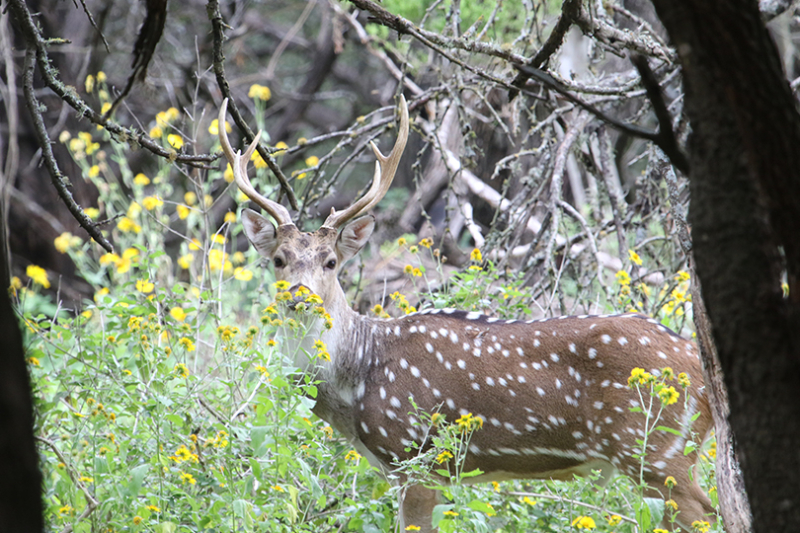By Jessica Domel
Multimedia Reporter
Experts from Texas Tech University are working with landowners near Junction to get a better idea of how many invasive axis deer are in the area and how the species can be better managed to reduce the impact on agriculture and native white-tailed deer.
The research is an extension of Dr. Matthew Buchholz’s dissertation on axis deer.
“In Junction, they go right up to the edge of town. They are a significant issue,” Buchholz said in an interview with the Texas Farm Bureau Radio Network. “Herds of several hundred are not that uncommon in the area. Near South Llano River State Park, I’ve personally seen a herd that was probably 300 to 350 individuals.”
Junction isn’t the only area impacted by the growing axis deer population.
“We did record changes in the vegetation communities that could have impacts on the health of the ecosystem primarily along the river,” Buchholz said. “South Llano River is considered ecologically significant by the Texas Parks and Wildlife Department because it holds a number of endemic species, including Guadalupe Bass.”
Buchholz said any negative impacts on the health of the ecosystem near the river impacts land use around Junction and likely downstream.
“With the impacts we recorded from axis deer, they do have some potential substantial impacts that could have major concerns going downstream,” Buchholz said.
Axis deer can also displace native white-tailed deer.
“Axis are socially dominant to white-tail and will displace them from high value sets, such as optimal habitat. This could include supplemental feeders anywhere that basically has any kind of high value to the two species,” Buchholz said.
Displaced white-tailed deer are then pushed into areas with fewer, or lower quality, food sources.
“As axis densities continue to increase, they could have substantial impacts on keeping white-tail densities and also producing these quality white-tail that a lot of landowners and hunters are trying to get,” Buchholz said.
As axis deer take over areas with better resources for deer, they can also destroy a habitat.
“One axis eats about as much as one-and-a-half white-tail,” Blake Leslie, research coordinator at the Llano River Field Station, said. “With these exploding numbers that we’re seeing, it puts a piece of property at a very high risk for habitat destruction as far as good availability and quality of forage.”
Axis deer also negatively impact agriculture.
“Axis are probably closer in competition with sheep and goats than anything else, and particularly along these river systems where axis primarily occur, there is some sheep and goat agriculture in those riparian habitats,” Buchholz said. “Axis come in, and they can wipe out a hayfield relatively easy.”
Axis deer are not native to Texas. They were brought here from India by a landowner.
“Axis were introduced in 1932 into a high fence property in Kerr County,” Buchholz said. “Via intentional releases—both to high fence properties and low fence—and also escapes, there’s been a large increase in the free-ranging population.”
Although there have been prior surveys, researchers don’t really know how many free-ranging axis deer there are in Texas.
“Axis have a really high reproductive ability,” Buchholz said. “They can have a fawn every nine months. Fawn survival is through to be very high—potentially in the 70 to 80% range.”
In comparison, white-tailed fawn survival is heavily dependent on precipitation.
“In a good year, white-tail survival may be 40%,” Buchholz said. “So, axis fawn survival could be twice what white-tail is. It allows for their population to grow very quickly.”
Axis deer also tend to live longer. The oldest doe recorded was 15 years old.
With hunting, an old white-tailed doe in the area may be seven to eight years old.
To get a better idea of axis deer numbers in the area, so they can better be managed, the team is looking for ranch owners who are willing to allow spotlight surveys on their property.
“As part of his (Buchholz’s) research project, he created some very detailed protocols for how we’re going to be doing these spotlight surveys,” Leslie said. “Initially, nearly all of them were conducted on county roads. Now, we’re looking to transition from county roads to surveying on ranches.”
Leslie said there have been surveys in the past, but those likely drastically underestimated the number of axis deer.
“We are actively looking for people who own ranches in the Junction areas,” Leslie said. “Getting support from local people is going to become more and more important to what we’re trying to do out here with the spotlight surveys and a number of the other projects that we’re going to be starting soon or have already started.”
Interested landowners from the Junction area can contact Leslie at the Texas Tech University campus in Junction or by emailing blake.leslie@ttu.edu.

